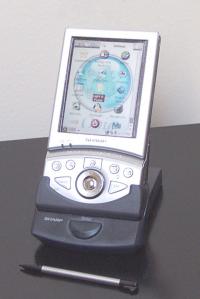 Last night I was able to get my hands on a great piece of hardware and a first in mobile device history. The Sharp Zaurus SL-5500 (Collie), was the first of the Linux-based Zaurus series to be sold outside Japan, where it was the most popular PDA of the 1990s. This gadget is based on the Intel SA-1110 StrongARM processor running at 206 MHz, has 64 MB of RAM and 16MB Flash, a built-in keyboard, CompactFlash (CF) slot, Secure Digital (SD) slot, and Infrared port.
Last night I was able to get my hands on a great piece of hardware and a first in mobile device history. The Sharp Zaurus SL-5500 (Collie), was the first of the Linux-based Zaurus series to be sold outside Japan, where it was the most popular PDA of the 1990s. This gadget is based on the Intel SA-1110 StrongARM processor running at 206 MHz, has 64 MB of RAM and 16MB Flash, a built-in keyboard, CompactFlash (CF) slot, Secure Digital (SD) slot, and Infrared port.Besides the fact that the SL-5500 is officially by now a pre-historic device in the IT industry, it is still quite an amazing feat of engineering, and it will definitely be very useful to SCYP.
I have managed to wipe out the original Sharp ROM, and flash the alternative OpenZaurus OS, a Debian-based embedded Linux distribution running OPIE as the GUI. OPIE is actually based on Qt, a mobile software development suite that is getting pretty popular these days, specially since the new version, Qt4, will be compatible with Windows, Windows Mobile and MacOS X. This means we can use the Sharp Zaurus SL-5500 to develop applications that may be easily portable to non-Linux systems (that's a lot of them!). So if any UofT student out there is interested, the PDA is right here in my desk at the ATRC waiting for an eager hacker!
